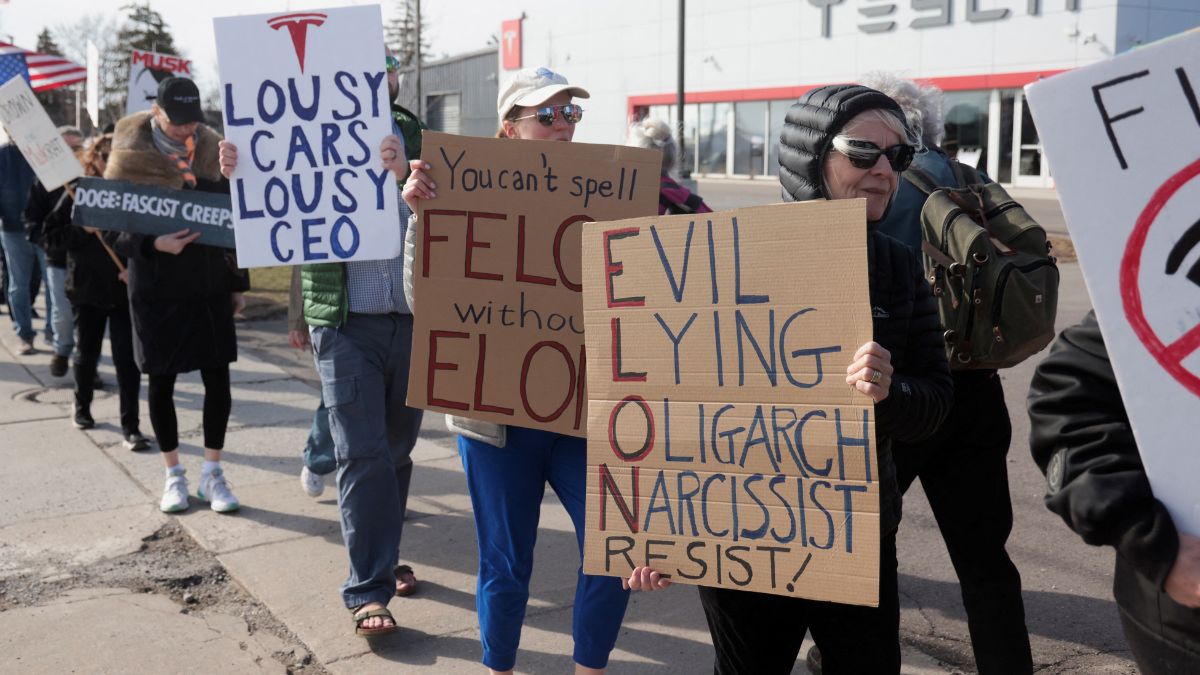On Saturday, April 5, Americans in every state are participating in a sweeping wave of coordinated protests under the banner “Hands Off!” — a large-scale demonstration against the policies and political direction of United States President Donald Trump and his close ally, Elon Musk.
Organisers say the movement represents one of the most significant public mobilisations since Trump’s return to office and may be the largest single-day protest of his second term.
The movement, which cuts across political, economic, and social fault lines, has galvanised a coalition of advocacy groups, labour unions, veterans, civil rights activists, climate campaigners, and LGBTQ+ organisations.
According to campaign organisers, over 1,200 protest events have been scheduled nationwide, with at least one demonstration planned in each of the 50 states.
How the protests originated
The Hands Off! campaign originated in response to what activists describe as a “hostile takeover” of American governance by an alliance of wealthy elites, fronted by Trump and Musk.
The protest’s official website asserts: “This is not just corruption. This is not just mismanagement. This is a hostile takeover.”
The campaign’s central message is a firm rejection of sweeping federal cuts, deregulation, and what it frames as the erosion of constitutional protections under the Trump administration.
According to organisers, the demonstrations seek to address three primary demands:
A halt to what they describe as a “billionaire takeover” of government institutions.
An end to defunding or restructuring programmes like Social Security, Medicare, and Medicaid.
A stop to policies perceived as discriminatory toward immigrants, transgender individuals, and other marginalised communities.
The protest’s website declares: “They want to strip America for parts — shuttering Social Security offices, firing essential workers, eliminating consumer protections, and gutting Medicaid — all to bankroll their billionaire tax scam.” It continues: “They’re handing over our tax dollars, our public services, and our democracy to the ultra-rich. If we don’t fight now, there won’t be anything left to save.”
How Elon Musk is involved in this
Adding fuel to the protests is a growing backlash against Elon Musk’s rising influence in the federal government. In particular, demonstrators are calling attention to his advisory role in the Department of Government Efficiency (Doge), an agency reportedly spearheading extensive cost-cutting measures across federal departments.
Critics argue that this department is responsible for sweeping layoffs and reductions in essential public services under the guise of eliminating “waste.”
While Musk has defended his initiatives by saying they are saving taxpayers billions, protest leaders claim the changes are dismantling vital parts of the federal infrastructure.
These concerns have been further amplified by the global #TeslaTakedown campaign, which began last year in response to Musk’s corporate practices and now links corporate accountability with government transparency.
Scale of the protests and locations
As of March 29, organisers reported over 250,000 RSVPs for events scheduled on April 5. By the day before the protests, that number had grown to nearly 400,000, according to Indivisible, one of the primary organising partners.
Demonstrations are taking place in city centres, public squares, state capitols and in front of federal buildings and congressional offices.
Some of the largest gatherings are expected in Washington, DC, where at least 12,000 protestors are anticipated to rally on the National Mall.
The protest programme in the US capital is scheduled to begin midday at the Sylvan Theater, with appearances from Democratic lawmakers including Representative Jamie Raskin of Maryland and Representative Maxwell Frost of Florida, reported Axios.
Due to the anticipated scale of the event in DC, the White House postponed its annual spring garden tours from Saturday to Sunday “out of an abundance of caution.”
A complete list of demonstrations includes locations in all state capitals — from Anchorage, Alaska, to Miami, Florida. Cities like San Francisco, Philadelphia, Boston, Atlanta, and Denver are also expected to see significant turnouts.
Smaller events are planned on university campuses and local community centres, highlighting the grassroots nature of the campaign.
Who is leading the movement
Nearly 200 organisations are partnering to support the Hands Off! initiative.
Among them are nationally recognised groups such as the American Civil Liberties Union (ACLU), Indivisible, MoveOn, the Human Rights Campaign, the Planned Parenthood Action Fund, the Center for LGBTQ Economic Advancement & Research, the League of Women Voters, Third Act, and Reproductive Freedom for All.
The protest effort was preceded by several preparatory events, including a virtual de-escalation training on Wednesday and an information session on Tuesday that drew nearly 35,000 online attendees.
These sessions were designed to ensure that all participants understood the movement’s commitment to peaceful demonstration. The campaign points out a nonviolent philosophy, stating that de-escalation is expected if any confrontations arise.
Axios quoted ACLU Chief Political and Advocacy Officer Deirdre Schifeling who explained during the online event: “Whether they get away with any particular effort doesn’t matter as much as the message that they are sending so loud and so clear, which is sowing fear, sowing the feeling of powerlessness.”
Third Act, a group co-founded by environmentalist Bill McKibben, has mobilised older Americans into the campaign, reported Newsweek. Its website states: “Donald Trump and Elon Musk think this country belongs to them. They’re grabbing everything they can, and it’s up to us to push back. On April 5th, we’ll take to the streets with a clear message: Hands off!”
A turning point for public action?
The Hands Off! protests are taking place at a politically tense moment, with ongoing legal proceedings involving Trump dominating headlines and a divisive national conversation about the direction of US governance.
Republican members of Congress have faced increased scrutiny during public town halls over their support for the administration’s policies.
Critics have raised concerns that while Trump has publicly claimed that Social Security and Medicare benefits will not be cut, the administration’s budget and federal efficiency goals cannot be met without significantly reducing services or eligibility — an issue that remains contentious.
Protesters also argue that many of the administration’s actions are disproportionately targeting already vulnerable communities.
Organisers are positioning this protest as a continuation of past resistance movements such as the 2017 Women’s March, the 2020 Black Lives Matter demonstrations and recent protests over voter suppression and climate inaction.
In one of the campaign’s most forceful statements, the website reads: “This is the moment where we say NO. No more looting, no more stealing, no more billionaires raiding our government while working people struggle to survive.”
Though protest movements in the past have targeted either Trump or Musk individually, Hands Off! is notable for its broad coalition and its scale. Advocacy group MoveOn has described it as the most extensive single-day action since the beginning of Trump’s second term.
Many participants see this protest as a launching point for sustained civic engagement. While Saturday’s demonstrations are intended as a peak moment, organisers have confirmed that more days of action are being planned throughout the summer and into the election season.
Protesters are being encouraged to bring signs, participate in chants, and engage in peaceful civil disobedience.
With inputs from agencies


)
)
)
)
)
)
)
)
)



